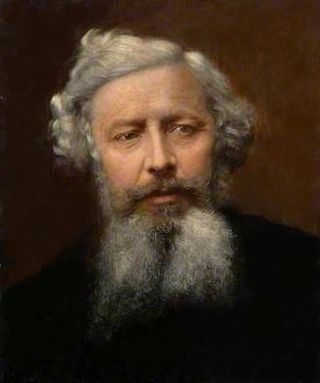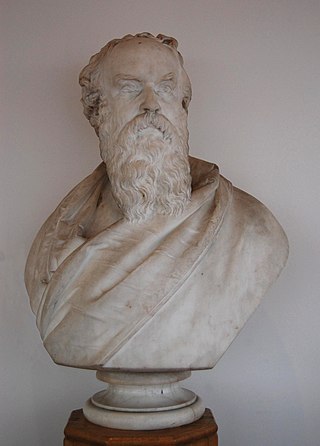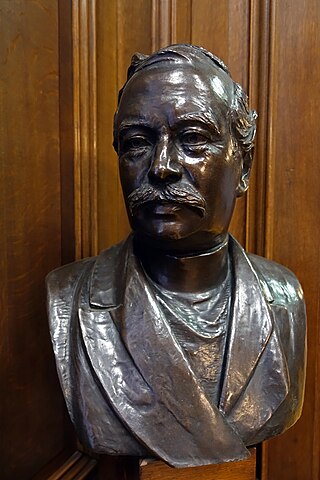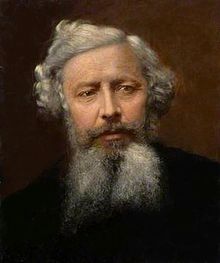
Joseph Chamberlain was a British statesman who was first a radical Liberal, then a Liberal Unionist after opposing home rule for Ireland, and eventually served as a leading imperialist in coalition with the Conservatives. He split both major British parties in the course of his career. He was the father, by different marriages, of Nobel Peace Prize winner Austen Chamberlain and of Prime Minister Neville Chamberlain.

The United Kingdom of Great Britain and Ireland was a sovereign state in Northwestern Europe that was established by the union in 1801 of the Kingdom of Great Britain and the Kingdom of Ireland. The establishment of the Irish Free State in 1922 led to the remainder later being renamed the United Kingdom of Great Britain and Northern Ireland in 1927.

George Dawson was an English nonconformist preacher, lecturer and activist. He was an influential voice in the calls for radical political and social reform in Birmingham, a philosophy that became known as the Civic Gospel.

Robert William Dale was an English Congregational church leader based in Birmingham.

Birmingham has seen 1400 years of growth, during which time it has evolved from a small 7th century Anglo Saxon hamlet on the edge of the Forest of Arden at the fringe of early Mercia into a major city. A combination of immigration, innovation and civic pride helped to bring about major social and economic reforms and create the Industrial Revolution, inspiring the growth of similar cities across the world.
The Radicals were a loose parliamentary political grouping in Great Britain and Ireland in the early to mid-19th century who drew on earlier ideas of radicalism and helped to transform the Whigs into the Liberal Party.

John Henry Chamberlain, generally known professionally as J. H. Chamberlain, was a British nineteenth-century architect based in Birmingham.
The National Education League was a political movement in England and Wales which promoted elementary education for all children, free from religious control.

Jesse Collings was Mayor of Birmingham, England, a Liberal member of Parliament, but was best known nationally in the UK as an advocate of educational reform and land reform.
Municipal socialism is a type of socialism that uses local government to further socialist aims. It is a form of municipalism in which its explicitly socialist aims are clearly stated. In some contexts the word "municipalism" was tainted with the concept of provincialism. However when it was adopted by various socialist networks in the late nineteenth century, this approach to socialist transformation spread across Europe and North America. Following electoral success in a number of localities, by the early twentieth century discussion of municipal socialism took on a more practical character, as Edgard Milhaud, Professor of Political Economy at the University of Geneva. established Annales de la Régie Directe, an academic journal which set out to scientifically examine the initial steps towards transforming areas previously dominated by private enterprise into new forms of public service. This journal contributed to a growing network of municipal socialists in Europe and North America, in which three types of movements were united at a local level: trade unions particularly of municipally run public services such as gas, transport, sewage etc., consumer and industrial co-operatives, and other associations of consumers including tenants groups opposed to price and rent increases.

Samuel Timmins was a British Shakespearean scholar and antiquarian. He was invariably known as Sam Timmins, and signed himself "Sam: Timmins", using a colon for abbreviation in early modern style.
The Martineau family is an intellectual, business and political dynasty associated first with Norwich and later also London and Birmingham, England. The family were prominent Unitarians; a room in London's Essex Hall, the headquarters building of the British Unitarians, was named after them. Martineau Place in Birmingham's central business district was named in their honour.

Francis Schnadhorst was a Birmingham draper and English Liberal Party politician. He briefly held elected office on Birmingham Council, and was offered the chance to stand for Parliament in winnable seats, but he found his true metier was in political organisation and administration both in his home town as secretary of the highly successful Birmingham Liberal Association from 1867 to 1884, and nationally as secretary of the newly formed National Liberal Federation from 1877 to 1893. He was famously described as "the spectacled, sallow, sombre" Birmingham draper who within a short period of time was to establish himself through the Birmingham Liberal caucus as one of the most brilliant organisers in the country.

Birmingham has a distinctive culture of art and design that emerged in the 1750s, driven by the historic importance of the applied arts to the city's manufacturing economy. While other early industrial towns such as Manchester and Bradford were based on the manufacture of bulk commodities such as cotton and wool, Birmingham's economy from the 18th century onwards was built on the production of finished manufactured goods for European luxury markets. The sale of these products was dependent on high-quality design, and this resulted in the early growth of an extensive infrastructure for the education of artists and designers and for exhibiting their works, and placed Birmingham at the heart of debate about the role of the visual arts in the emerging industrial society.

The Nonconformist conscience was the moralistic influence of the Nonconformist churches in British politics in the 19th and early 20th centuries. Nonconformists, who were dissenters from the Church of England, believed in the autonomy of their churches and fought for religious freedom, social justice, and strong moral values in public life.

William Harris was a Liberal politician and strategist in Birmingham, England, in an era of dramatic municipal reform. On his death, he was described by one obituary-writer as "one of the founders of modern Birmingham". J. L. Garvin called him "the Abbé Sieyès of Birmingham" ; and Asa Briggs "a most active and intelligent wire-puller behind the scenes". He was dubbed the "father of the Caucus", the highly organised and controversial Liberal party machine that had its origins in Birmingham, but was afterwards introduced at national level to the National Liberal Federation. He served as the first Chairman of the National Liberal Federation from 1877 to 1882. By profession he was an architect and surveyor; and he was also a prolific journalist and author.
James Beal (1829–1891) was an English land agent and auctioneer, known as a London reformer. Over many years he was a prominent radical.

Charles Vince (1823–1874) was a noted and popular Baptist minister in Birmingham, England, at the Graham Street chapel from 1852 to 1874. He was one of the religious leaders developing Birmingham's Civic Gospel, with his predecessor at the chapel George Dawson, and Henry William Crosskey.

John Glasse (1848–1918) was a Church of Scotland Minister at Greyfriars Kirk, Edinburgh, Scotland, 1877-1909. He was a leading advocate of Christian Socialism, and was described by Sidney Webb as one of the "two most influential Scottish socialists".















